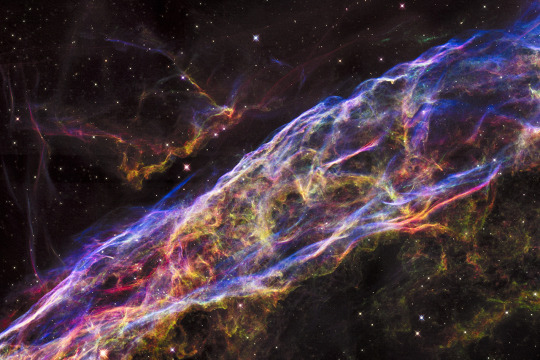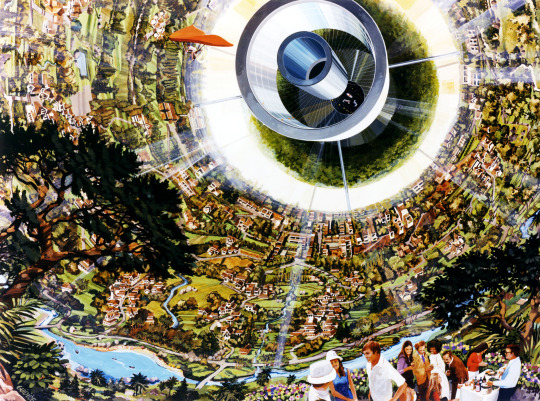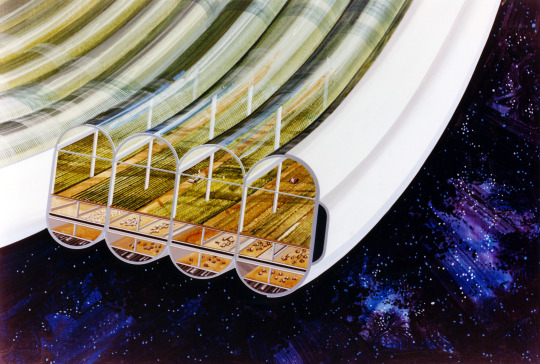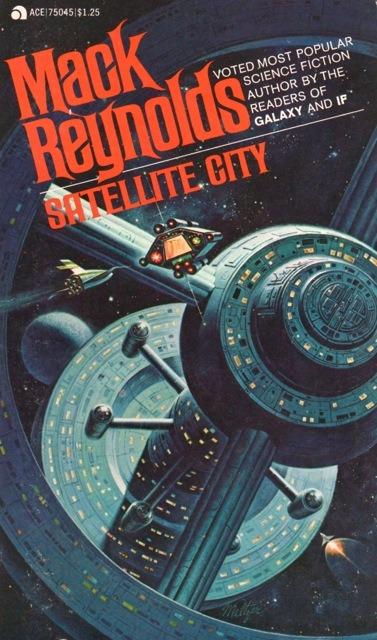A digital library of space art, scientific illustrations, and visions of the future that will (hopefully) grow into a master's thesis in the history of science, technology, and medicine by the spring of 2022. So dive in, and in the words of Ray Bradbury, don't think. Cover image: "The Toroidal Colony", Rick Guidice, 1975. Courtesy of NASA Ames Research Center via Flickr.
Don't wanna be here? Send us removal request.
Text

The stunning Veil Nebula was created after a star about 20 times the mass of the Sun lived fast and died young – exploding in a cataclysmic release of energy known as a supernova.
In a violent stellar explosion roughly 10,000 years ago, shockwaves and debris created this staggeringly beautiful trail through space. The picture above shows a mosaic of six Hubble Space Telescope pictures, a small area roughly two light-years across, and only a tiny fraction of the nebula's vast 110 light-year structure.
To learn more about Hubble’s celebration of nebula November and see new nebula images, visit our space telescope's nebula page.
You can also keep up with Hubble on Twitter, Instagram, Facebook, and Flickr!
Image credits: NASA, ESA, and the Hubble Heritage Team (STScI/AURA)
3K notes
·
View notes
Photo


(1) “Bernal Interior”, Rick Guidice, 1975. NASA ID: AC76-0628.
Featured in the 1977 publication Space Settlements: A Design Study (NASA SP-413), a document authored by “the participants of the 1975 Summer Faculty Fellowship Program in Engineering Systems Design”. This session was cohosted by NASA Ames Research Center and Stanford University.
Featured in the 1977 book The High Frontier: Human Colonies in Space by Gerard K. O’Neill. O’Neill offers a more detailed description of the work, writing that it depicts the “interior of Island One”, a Bernal-sphere style space habitat designed to house 10,000–20,000 people. O’Neill’s caption also notes that “houses and apartments are shown oriented to sunshine” in Guidice’s painting.
(2) “Bernal Agriculture”, Rick Guidice, 1975. NASA ID: AC78-0330-4.
Image credit: NASA on The Commons via Flickr (1) and (2)
2 notes
·
View notes
Photo



Earth II, Tom Gries, 1971. Promotional artwork by unknown artist.
Silent Running, Douglas Trumbull, 1972. Promotional artwork by George Akimoto.
Futureworld, Richard T. Heffron, 1976. Promotional artwork by Drew Struzan.
Image credits: Earth II, Silent Running, Futureworld films.
10 notes
·
View notes
Photo

“Satellite City”, 1975. Cover art by Davis Meltzer.
Image credit: Satellite City by Dallas McCord “Mack” Reynolds.
2 notes
·
View notes
Photo


(1) “After the Festival”, Vincent di Fate, 1978.
Featured on the cover of the pulp magazine Analog Science Fiction/Science Fact, April 1977.
(2) “To Bring in the Steel”, Vincent di Fate, 1978.
Featured as interior art in the pulp magazine Analog Science Fiction/Science Fact, July 1978.
Image credit: Vincent di Fate Aerospace Gallery and Vincent di Fate Science Fiction Gallery.
#vincent di fate#space art#space colonization#1970s#architecture#analog science fiction/science fact#vintage pulp
6 notes
·
View notes
Photo

“Domed Colony on Mars”, Chesley Bonestell, 1976.
Image credit: Chesley Bonestell Image Gallery.
Hello all! After a solid thirteen or so hours of scouring the Internet for imaginative space colony images from the 1970s, welcome to the first (but certainly not the last) pieces of my master’s thesis art collection! To narrow the focus of my master’s thesis, the bulk of the images posted here will be...
produced, created, or otherwise imagined during the 1970s
limited to stories in which earth (and earth colonies) exists
In the spirit of full disclosure, these images will also momentarily focus on American space art endeavors, as that’s currently the subset of space history in which I have the most experience, but I do hope to expand this project (ideally in my phd work) to non-American visions of space colonization. Thoughts and observations on the pieces gathered will be forthcoming, but in the meantime, enjoy this gorgeous artwork!
Additionally, as a gentle shout out to any fellow space art nerds, grad students, or sci-fi fans, check out these digital resources if you haven’t already heard of them, they really will safe your life:
The Internet Speculative Fiction Database - a super useful tool that not only tracks obscure publications but will try to point to the provenance of each piece created by a particular artist or author (including some zines).
The Internet Archive - a wonderful database with wide selections of popular pulp publications like Amazing Stories, If, Galaxy, Analog Science Fiction Magazine, Starlog Future Life Magazine, etc.
#chesley bonestell#space art#1970s#environment#architecture#grad school#space history#research#future#urban planning
0 notes
Text
the studio is an absolutely incredible organization in jpl. check out the studio’s latest work here: the galaxy of horrors. it’s a great way to celebrate halloween, my fellow space-obsessed ghosts and ghouls :)
The Exploration Behind the Inspiration at NASA
Are we alone? How did we get here? Where are we headed?
At NASA, our mission is to explore. We visit destinations in our solar system and study worlds beyond to better understand these big questions.
We also dream. We dream of traveling to distant worlds, and what that might be like. In the video above you can see fanciful, imagined adventures to real places we’ve studied at NASA.
How We Did It
Check out how we created these otherworldly scenes in the video below. A NASA videographer used green screens to add motion and real people to bring life to our series of solar system and exoplanet travel posters.
youtube
Let’s dive into one example from the video. The shot of kayaking on Titan showcases the real rivers and lakes of liquid methane and ethane that slosh and flow on Saturn's largest moon. Titan's mysterious surface was revealed by our Cassini spacecraft, which also deployed the European Space Agency’s Huygens probe to the surface. The atmosphere on Titan is so thick, and the gravity so light, that with each strike of a paddle, you might be lofted above the swift current as you ride the tides through a narrow strait called the Throat of Kraken. NASA scientist Mike Malaska studies Titan and collaborated on the poster featured in the video. His research informed the artwork, and so did a hobby: kayaking. Those ultra-cold chemical seas might be even more of a challenge than shown here. Your boat might crack, or even dissolve, Malaska said.

We’ll learn more about Titan when our Dragonfly mission of dual quadcoptors — rotorcraft with eight blades each — visits the icy moon in 2034.
Science Never Stops
Our understanding of other worlds is always evolving, and sometimes we learn new details after we illustrate our science. In one of our travel posters, we show a traveler standing on the surface of exoplanet Kepler-16b with two shadows formed by the planet’s two suns. The planet does indeed orbit two stars, but with later size and mass refinements, we now think it would be hard to stand there and enjoy a binary sunset. There isn't a solid surface to stand on a gas planet, and that's what Kepler-16b now appears to be!
youtube
In addition to sharing how sublime science can be, these scenes are a reminder that there are lots of careers in the space program, not just scientist, engineer, or astronaut. A creative team at NASA’s Jet Propulsion Laboratory in Southern California produced the travel posters, originally to help share the work of NASA's Exoplanet Exploration Program. They are the result of lots of brainstorming and discussion with real NASA scientists, engineers, and expert communicators. The video versions of these spacey travel scenes were produced by visualization experts at NASA’s Goddard Space Flight Center in Greenbelt, Maryland.
All of this work is meant to inspire, and to explore the edge of possibility. It’s also an invitation. With science, we’re stepping into the future. Join us?
730 notes
·
View notes